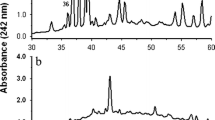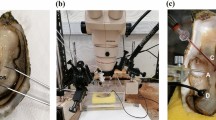Abstract
Electro-olfactograms were used to determine sensitivity and specificity of olfactory organs of female sea lampreys (Petromyzon marinus) to four bile acids: 3-keto petromyzonol sulfate and 3-keto allocholic acid from spermiating males and petromyzonol sulfate and allocholic acid from larvae. Spermiating male bile acids are thought to function as a mating pheromone and larval bile acids as a migratory pheromone. The response threshold was 10−12 mol l−1 for 3-keto petromyzonol sulfate and 10−10 mol l−1 for the other bile acids. At concentrations above 10−9 mol l−1, the sulfated bile acids showed almost identical potency, as did the non-sulfated bile acids. The two sulfated bile acids were more potent than the two non-sulfated ones. In addition, 3-keto petromyzonol sulfate and water conditioned with spermiating males induced similar concentration-response curves and response thresholds. Cross-adaptation experiments demonstrated that the sulfated and non-sulfated bile acids represent different odors to the olfactory epithelium of females. Further exploration revealed that 3-keto petromyzonol sulfate represents a different odor than petromyzonol sulfate, while 3-keto allocholic acid and allocholic acid represent the same odor. Results indicate that male-specific bile acids are potent and specific stimulants to the female olfactory organ, supporting the previous hypothesis that these bile acids function as a pheromone.



Similar content being viewed by others
Abbreviations
- 3kACA:
-
3-keto allocholic acid
- 3kPZS:
-
3-keto petromyzonol sulfate
- ACA:
-
allocholic acid
- ANOVA:
-
analysis of variance
- ELISA:
-
enzyme-linked immunosorbent assay
- EOG:
-
electro-olfactogram
- PIR:
-
percent initial response
- PZS:
-
petromyzonol sulfate
- SMW:
-
spermiating male washings
References
Applegate VC (1950) Natural history of the sea lamprey (Petromyzon marinus) in Michigan. US Fish Wildl Serv Spec Sci Rep Fish Serv No 55
Bjerselius R, Li W, Teeter JH, Johnsen PB, Maniak PJ, Grant GC, Polkinghorne CN, Sorensen, PW (2000) Direct behavioural evidence that unique bile acids released by larval sea lamprey (Petromyzon marinus) function as a migratory pheromone. Can J Fish Aquat Sci 57:557–569
Caprio J, Byrd RP (1984) Electrophysiological evidence for acidic, basic, and neutral amino acid olfactory receptor sites in the catfish. J Gen Physiol 84:403–422
Døving KB, Selset R, Thommesen G (1980) Olfactory sensitivity to bile acids in salmonid fishes. Acta Physiol Scand 108:123–131
Hara TJ (1994) The diversity of chemical stimulation in fish olfaction and gustation. Rev Fish Biol Fish 4:1–35
Hardisty MW, Potter IC (1971) The general biology of adult lampreys. In: Hardisty MW, Potter IC (eds) The Biology of lampreys, vol. 1. Academic Press, New York, pp 127–206
Haslewood GA, Tokes L (1969) Comparative studies of bile salts. Bile salts of the lamprey Petromyzon marinus L. Biochem J 114:179–184
Hellstrøm T, Døving KB (1986) Chemoreception of taurocholate in anosmic and sham- operated cod, Gadus morhua. Behav Brain Res 21:155–162
Jones KA, Hara TJ (1985) Behavioural responses of fishes to chemical cues: results from a new bioassay. J Fish Biol 27:495–504
Li W (1994) The olfactory biology of sea lamprey (Petromyzon marinus). PhD dissertation, University of Minnesota, St. Paul, USA
Li W, Sorensen PW (1997) Highly independent olfactory receptor sites for naturally occurring bile acids in the sea lamprey, Petromyzon marinus. J Comp Physiol A 180:429–438
Li W, Sorensen PW, Gallaher DD (1995) The olfactory system of migratory adult sea lamprey (Petromyzon marinus) is specifically and acutely sensitive to unique bile acids released by conspecific larvae. J Gen Physiol 105:567–587
Li W, Scott AP, Siefkes MJ, Yan H, Liu Q, Yun S-S, Gage DA (2002) Bile acid secreted by male sea lamprey that acts as a sex pheromone. Science 296:138–141
Michel WC, Lubomudrov LM (1995) Specificity and sensitivity of the olfactory organ of the zebrafish, Danio rerio. J Comp Physiol A 177:191–199
Moore HH, Schleen LP (1980) Changes in spawning runs of sea lamprey (Petromyzon marinus) in selected streams of Lake Superior after chemical control. Can J Fish Aquat Sci 37:1851–1860
Porkinghorne CN, Olson JM, Gallaher DD, Sorensen PW (2001) Larval sea lamprey release two unique bile acids to the water at a rate sufficient to produce detectable riverine pheromone plumes. Fish Physiol Biochem 24:15–30
Siefkes MJ, Bergstedt RA, Twohey MB, Li W (2003a) Chemosterilization of male sea lampreys does not affect sex pheromone release. Can J Fish Aquat Sci 60:23–31
Siefkes MJ, Scott AP, Zielinski B, Yun S-S, Li W (2003b) Male sea lampreys, Petromyzon marinus L., excrete a sex pheromone from gill epithelia. Biol Reprod 69:125–132
Sola C, Tosi L (1993) Bile acids and taurine as chemical stimuli for glass eels, Anguilla anguilla: a behavioral study. Environ Biol Fishes 37:197–204
Stabell OB (1987) Intraspecific pheromone discrimination and substrate marking by Atlantic salmon parr. J Chem Ecol 13:1625–1643
Vermeirssen ELM, Scott AP (2001) Male priming pheromone is present in bile, as well as urine, of female rainbow trout. J Fish Biol 1039–1045
Vrieze L, Sorensen PW (2001) Laboratory assessment of the role of a larval pheromone and natural stream odor in spawning stream localization by migratory sea lamprey (Petromyzon marinus). Can J Fish Aquat Sci 58:2374–2385
Yun S-S, Scott AP, Li W (2003) Pheromones of the male sea lamprey, Petromyzon marinus L: structural studies on a new compound, 3-keto allocholic acid, and 3-keto petromyzonol sulfate. Steroids 68:297–304
Yun S-S, Siefkes MJ, Scott AP, Li W (2002) Development and application of an ELISA for sea lamprey male sex pheromone. Gen Comp Endocrinol 129:163–170
Zhang C, Hara TJ (1994) Multiplicity of salmonid olfactory receptors for bile acids as evidenced by cross-adaptation and ligand binding assay. Chem Senses 19:579
Zhang C, Brown SB, Hara TJ (2001) Biochemical and physiological evidence that bile acids produced and released by lake char (Salvelinus namaycush) function as chemical signals. J Comp Physiol B 171:161–171
Acknowledgements
We thank Roger Bergstedt and the staff of US Geological Survey Hammond Bay Biological Station for accommodating us in their laboratory, and Michael Twohey and the staff of Marquette Biological Station for supplying us with sea lampreys. Dr. Sang-Seon Yun performed ELISA analysis and helped with bile acid preparation. Members of Li laboratory provided critique of an early version of this manuscript. The Great Lakes Fishery Commission financed this study. This research was approved by the Michigan State University, All University Committee on Animal Use and Care, and complied with all federal and state laws, policies, and rules for the humane use of laboratory animals in research.
Author information
Authors and Affiliations
Corresponding author
Rights and permissions
About this article
Cite this article
Siefkes, M.J., Li, W. Electrophysiological evidence for detection and discrimination of pheromonal bile acids by the olfactory epithelium of female sea lampreys (Petromyzon marinus). J Comp Physiol A 190, 193–199 (2004). https://doi.org/10.1007/s00359-003-0484-1
Received:
Revised:
Accepted:
Published:
Issue Date:
DOI: https://doi.org/10.1007/s00359-003-0484-1




